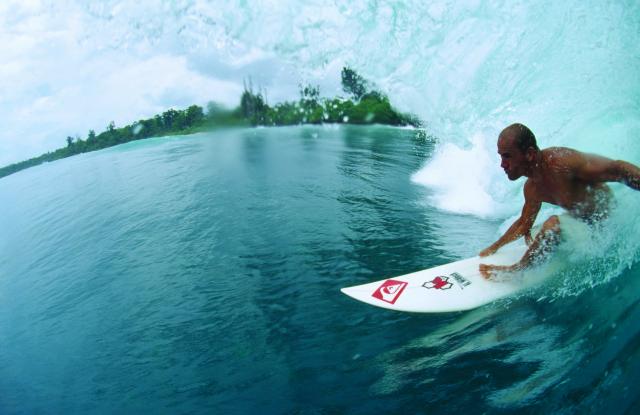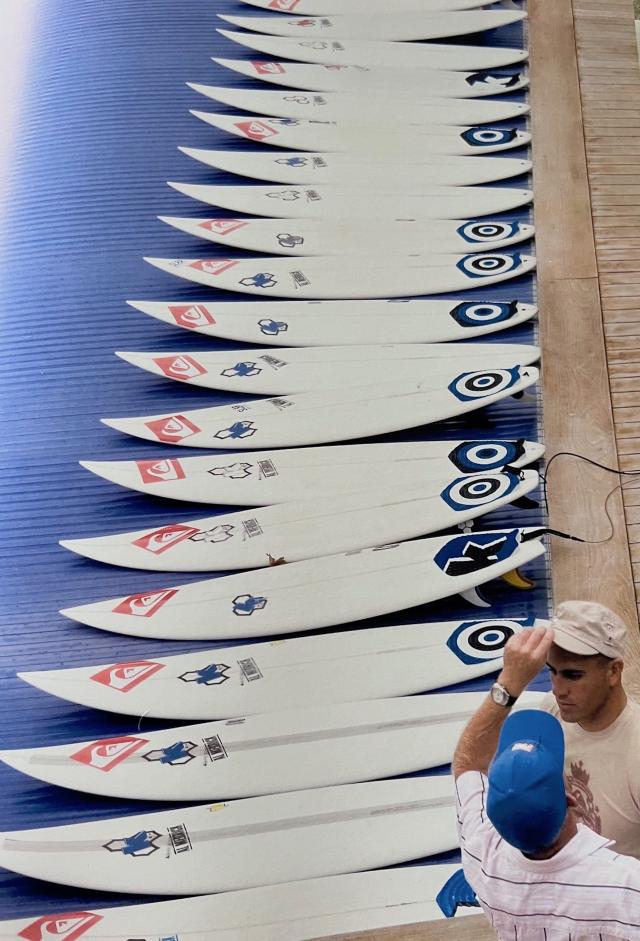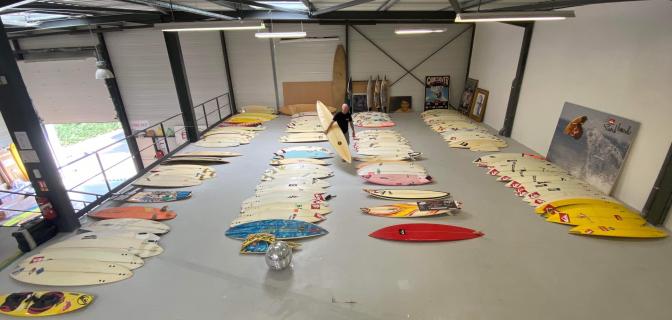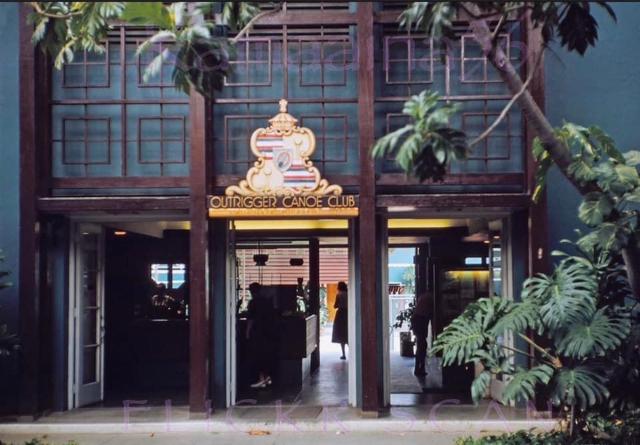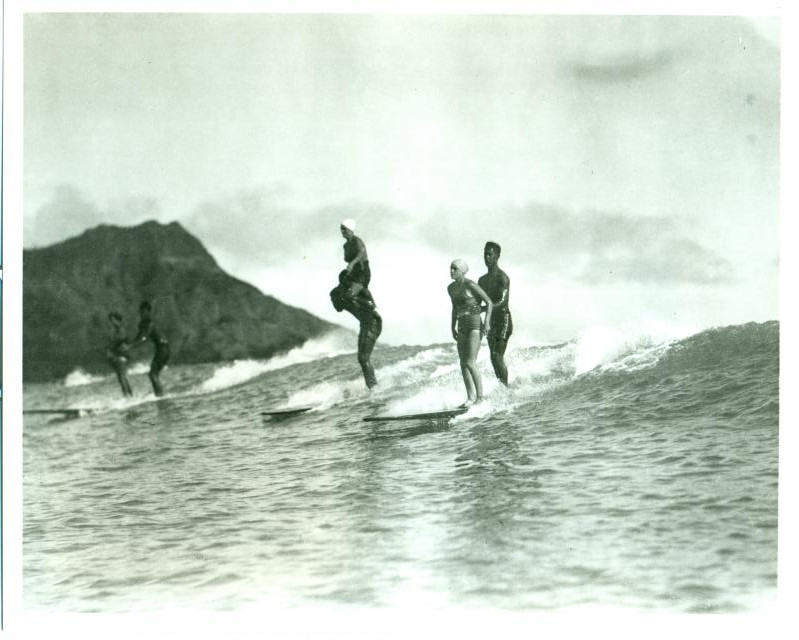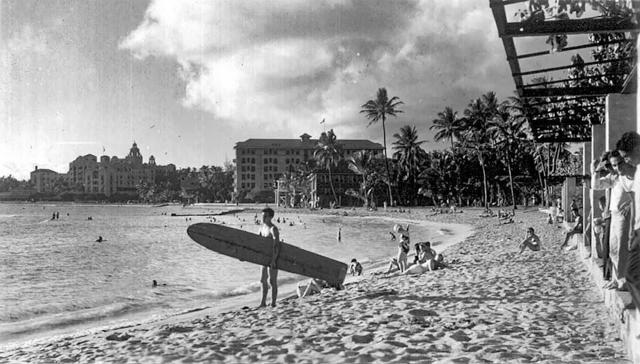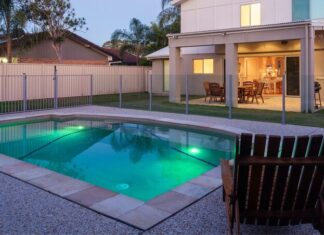For my sins I’ve been helping Noosa Surf Museum founder Keith Grisman trace the provenance of some of the surfboards in his immense collection of around 1100, spread around his Boarding Office hubs along the Sunshine Coast, and now of course in Noosa’s own museum.
You’d think that with my 50 plus years of researching and writing about surfing that would be relatively easy, but often it’s the ones that look the simplest that prove the most difficult. Take, for example, the Kelly Slater personal board pictured here, acquired by Keith from Kelly’s occasional shaper Akila Aipa through renowned Hawaiian collector Randy Rarick. Keith believed it to be the board on which Kelly won the 2008 Pipe Masters, thereby clinching his ninth world title.
While there seems to be little doubt that this board, six-feet-ten-inches in length, was part of Kelly’s contest quiver for that Hawaiian season, the board he actually rode to victory over Californian Chris Ward, 15 years ago this week, was a radical 5’11”, dubbed the Deep Six and almost a foot shorter than the board in the NSM. Channel Islands team manager Travis Lee explained at the time: “Kelly’s Deep Six board is a result of Al Merrick’s pursuit to place surfboard design in the hands of surfers themselves. Kelly worked with Channel Islands’ CAD software and library of designs to marry a 7’0” K-step and a 6’0” K-board into a completely original 5’11” with the wide point pushed forward.” (If you can work your way through the tech-speak, you’ll follow Trav’s line.)
A little more digging and I also discovered that the museum’s board was also not the board on which he was defeated by Andy Irons in the 2006 final, so where did that 6’11” figure in Slater history? As Keith points out, the fact that it was finish-shaped for Kelly by his original mentor and shaper Al Merrick, denoted by a tiny puka shell inside Al’s Christian fish logo, its general contours and its logo design and positioning pretty much carbon-date it to the period 2006-8. But what complicates the issue is the fact that over this period, between his eighth and ninth world titles, Kelly had literally hundreds of almost identical surfboards scattered around the world.
I was working with Kelly at the time on a book called For The Love, and I saw the evidence of this on a regular basis. In fact he told me: “I use more surfboards than just about anybody on the planet, and it troubles me on a daily basis.” To his credit, Kelly was working then and since on recyclable foam and soy-based resins, but the truly green surfboard remains elusive.
In France in September I caught up for lunch with old mate and Quiksilver colleague Stephen Bell, who was then in the throes of opening his new Bell Surfing factory and moving his collection of more than 140 Kelly Slater surfboards from the ceiling of his old factory to a new home at a surf museum in Hossegor. So faced with the problem of the CI 6’10”, I contacted the oracle, the man who managed Kelly at virtually every world tour event for 25 years, and one of his closest friends, known to some as “Belly Slater”.
Belly looked at the pictures and responded: “Yeah, definitely part of his personal quiver back then but at that extreme length, at a time when he was going the other way, and no deck pad or sign of where one has been, I’d say it’s possibly one he never, or rarely rode, and not in competition.”
Does that possibility diminish its interest factor? Absolutely not. It was part of one of the great shaper/surfer collaborations of the modern era, and who knows/ It may well be just out of this shot of the Kelly quiver, taken in the late Pierre Agnes’s covered pool in Capbreton for a magazine shoot. That’s Belly, adjusting Kelly’s cap for the pic, as he did.
Memories of the OCC
By the time I first visited the legendary Outrigger Canoe Club at Waikiki, it had already been in its second home for nearly a decade, up at Sans Souci Beach closer to Diamond Head.
In 1975 the new club didn’t have the history or the cool factor of the original, which grew like Topsy next to the Moana Hotel from 1908 until 1927 when it began to feel the squeeze from the newly-built Royal Hawaiian on the other side. It was only a matter of time and by the radical expansion of Waikiki in the ‘60s, it was demolished and a replacement built up past the old Natatorium, between the surf breaks of Publics and Castles. But it was to the OCC Mark II that I went on my first visit to Oahu to meet with Fred Hemmings, the 1968 world surfing champion, big wave hero and co-founder of surfing’s first pro tour.
I was reminded of this when I stumbled on a social media post from Fred Hemmings, waxing lyrical over a photo of the front entrance to the original club in the 1950s: “There were many canoes on the beach, all koa wood. Almost all the beach boys who took tourists surfing or canoe riding were pure Hawaiian. Those were the glimmering days of my youth in a tranquil Hawaii of old.”
Through the good offices of Hawaiian resident and friend “Baby Dave” Rochlen, I was later able to use the extensive archive of the club as my research base for a month while working on a book about Duke Kahanamoku, and I came to appreciate that “tranquil Hawaii of old” that Fred remembered. Here’s a little taste of it.

